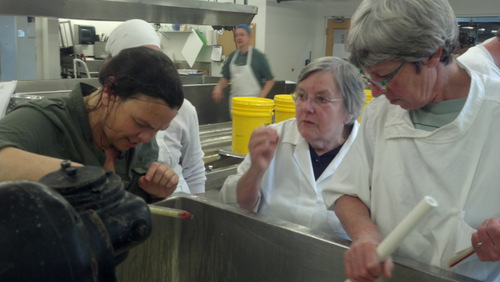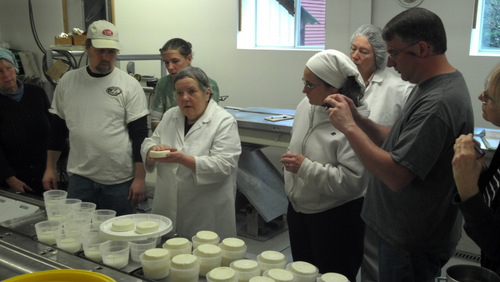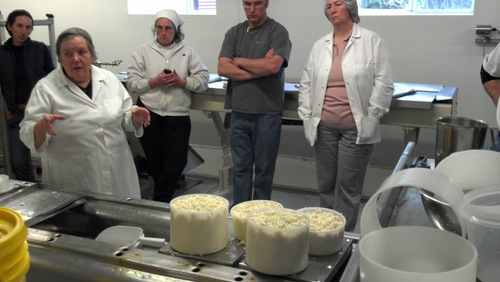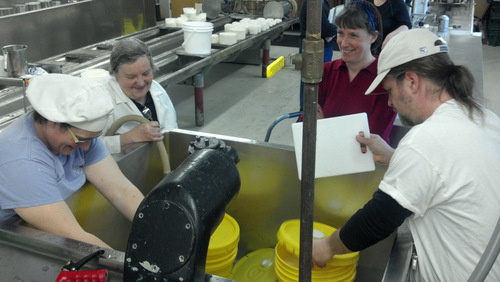 The village of Roquefort, France is located on the southern tip of the high Massif Central plateau about 100 miles from the Mediterranean Sea, and it is built into the cliffs containing the caves that “invented” blue cheese. Natural air currents vent these caves (called “fleurines“) and carry the naturally occurring Penicillium roqueforti spores through them, as well as keep the caves at a constant temperature and humidity. As part of the AOC definition of “Roquefort” cheese, all cheeses with that name must spend at least two weeks in these caves. This means that 24 hours a day trailer trucks full of young cheese are brought to the caves while each cheese that has already been two weeks in the caves are loaded back onto the same trailers and taken away to cold storage for final aging. Below are some pictures of the village, as well as of an antique cheese piercing machine that looks more like a medieval torture device (which is apt because long ago the Catholic Church purged non-believers from this region through a reign of torture and terror).
The village of Roquefort, France is located on the southern tip of the high Massif Central plateau about 100 miles from the Mediterranean Sea, and it is built into the cliffs containing the caves that “invented” blue cheese. Natural air currents vent these caves (called “fleurines“) and carry the naturally occurring Penicillium roqueforti spores through them, as well as keep the caves at a constant temperature and humidity. As part of the AOC definition of “Roquefort” cheese, all cheeses with that name must spend at least two weeks in these caves. This means that 24 hours a day trailer trucks full of young cheese are brought to the caves while each cheese that has already been two weeks in the caves are loaded back onto the same trailers and taken away to cold storage for final aging. Below are some pictures of the village, as well as of an antique cheese piercing machine that looks more like a medieval torture device (which is apt because long ago the Catholic Church purged non-believers from this region through a reign of torture and terror).
Continue reading
Category Archives: Learning
UMaine Workshops in June 2012
A Sanitation Workshop will be held at UMaine on June 5, 2012. Although not dairy specific, it is a great refresher course on general sanitation for the food industry. A separate workshop for meat and poultry HACCP will be held at UMaine on June 19 and 20, 2012. For more information and to register online, please visit this web site: http://umaine.edu/food-health/food-safety/sanitation-and-haccp-workshops/.
Now, We’ve Got The Blues

The British Blue Cheese Workshop led by Kathy Biss from West Highland Dairy in Scotland took place last weekend and the participating Guild members all took a lot away from it — information as well as workshop cheese that they will now age!

We made four recipes in two different milks for contrast:
- Blue Leicester — goats milk
- Ascaig Blue — cows milk
- Strathdon Blue — goats and cows milk
- Lymeswold — goats and cows milk
The first two are made with scalded curd for a firmer texture, more mechanical holes, and longer aging potential. The last two have a much higher moisture content, and the Lymeswold actually incorporates a bloomy rind with the blue interior, though it will age no more than four to six weeks.

The contrast between all of these recipes provided and excellent background on what is needed to adapt any recipe to a blue recipe, and how to work with Penicillium roqueforti, which digests the milk fats for its distinctive flavors, but requires oxygen to grow. That’s why piercing cheese wheels is necessary to allow blue to grow inside.

As with any workshop, much of the information applied to cheese making of all kinds, and most importantly what to do when your make isn’t progressing the way you would like. In this case we needed to re-warm the buckets in which we were making the Strathdon Blue on the second day because the acid was not developing, which was evident because the curd was slow to reach the right texture.
Overall a great experience for Maine (and beyond Maine) cheese makers.
Kathy Biss will return the following weekend to lead a workshop on making Hard British Cheeses.
